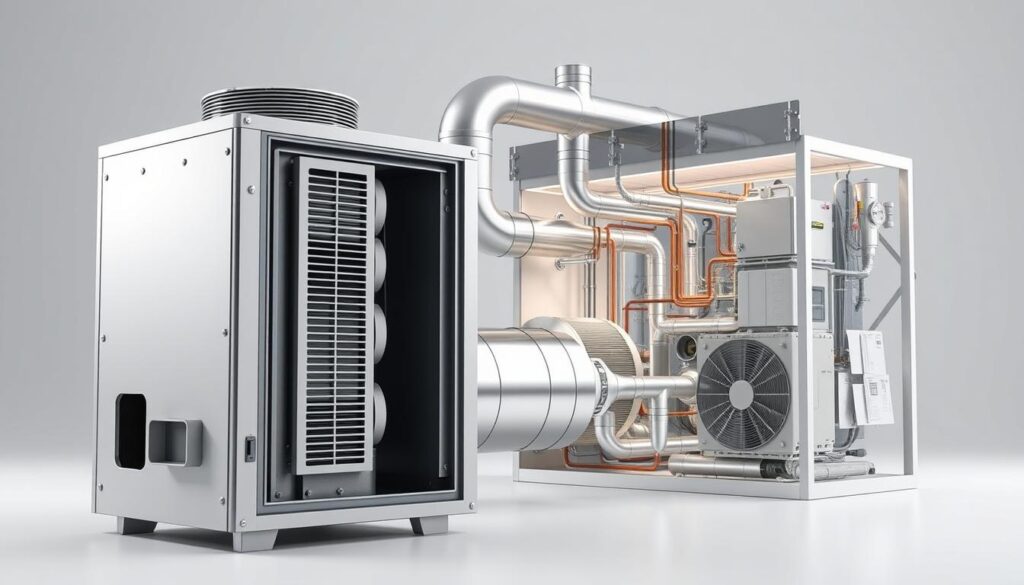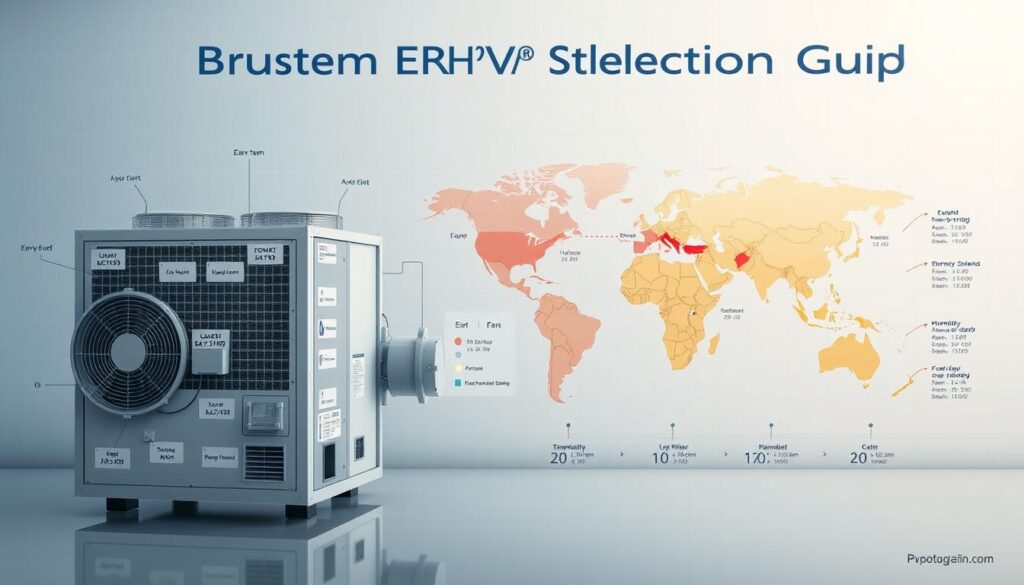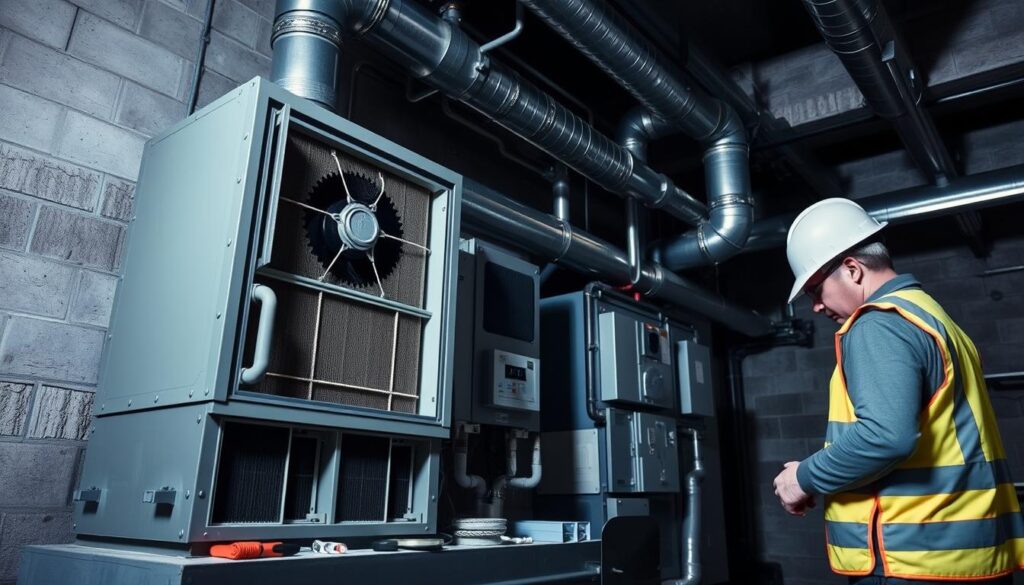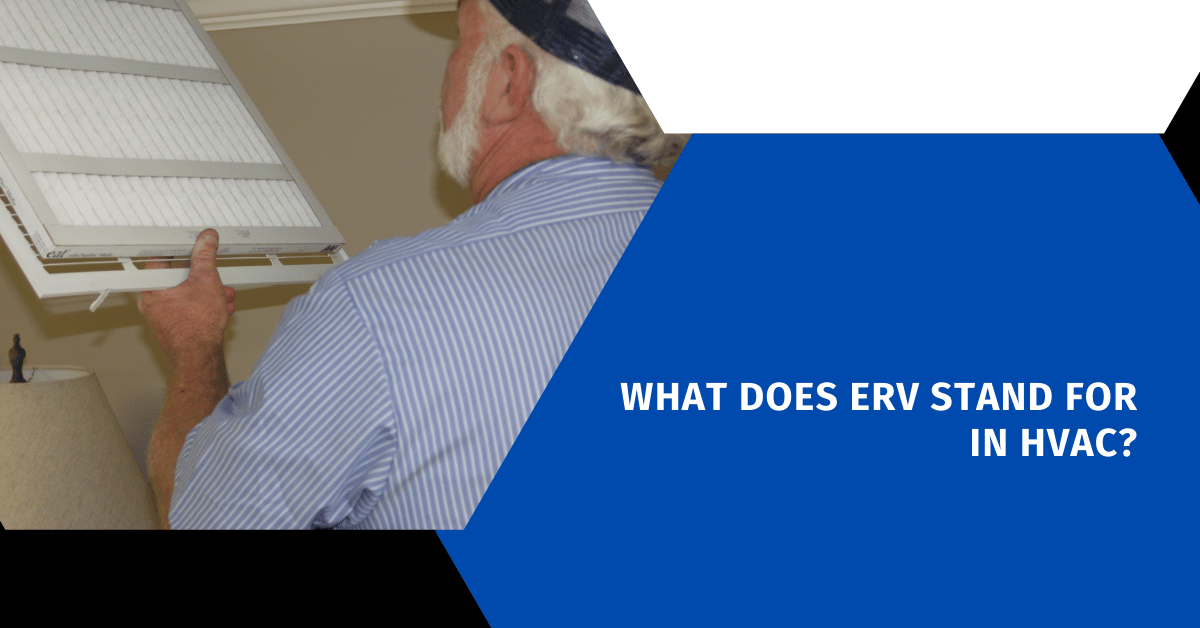Affiliate Disclosure
HVAC Guide Guys is a participant in the Amazon Services LLC Associates Program, an affiliate advertising program designed to provide a means for sites to earn advertising fees by advertising and linking to Amazon.
What Does ERV Stand for in HVAC? Are you tired of high energy bills and poor indoor air quality? What if a single technology could change your home’s ventilation and save you money? Energy Recovery Ventilators (ERV) might be the answer you’ve been looking for in your HVAC system.

An Energy Recovery Ventilator, or ERV, is a smart ventilation technology. It improves your home’s air quality and cuts down on energy use. When you ask what does ERV stand for in HVAC, the answer is clear: it’s a system that makes you breathe better and saves you money on bills.
Unlike old ventilation methods, an energy recovery ventilator exchanges indoor and outdoor air smartly. It keeps your home’s temperature and humidity just right. This smart way ensures fresh air flows without losing comfort or energy efficiency.
Key Takeaways
- ERV stands for Energy Recovery Ventilator
- Improves indoor air quality significantly
- Reduces energy consumption and utility costs
- Works seamlessly with existing HVAC systems
- Provides balanced ventilation for healthier homes
Table of Contents
Understanding ERV: The Basics of Energy Recovery Ventilation
Energy Recovery Ventilation (ERV) is a modern way to manage indoor air in HVAC systems. It helps improve air quality and save energy. This system is more advanced than old ventilation methods.
ERV systems balance air exchange to save energy and keep air quality high. It transfers heat and moisture between air streams. This makes your home’s air better while being energy-efficient.
Core Components of an ERV System
An ERV system has important parts that work well together:
- Two separate air fans
- Advanced heat exchanger
- Air filtration mechanism
- Moisture transfer membrane
How ERV Systems Function
ERV systems work by preparing fresh air before it enters your home. They use a heat exchanger to:
- Recover energy from exhaust air
- Regulate indoor temperature
- Control humidity levels
- Reduce overall HVAC energy consumption
The Role of Heat Exchange in ERV
Heat exchange is key to ERV systems. It transfers thermal energy between air streams. This makes ventilation efficient and keeps your home comfortable without wasting energy.
What Does ERV Stand for in HVAC?
ERV stands for Energy Recovery Ventilator. It’s a key part of modern HVAC systems. It changes how we think about indoor air quality and energy use.
Knowing how an ERV works helps you choose the right HVAC setup. It transfers energy between air streams. This makes your indoor space more comfortable and energy-efficient.
“Energy Recovery Ventilation is not just a technology, it’s a smart approach to managing indoor air quality and energy consumption.”
- Reduces energy consumption by recovering heat and moisture
- Improves indoor air quality through continuous ventilation
- Supports sustainable building practices
When you think about installing an ERV, remember its benefits. These systems swap stale air for fresh air. They do this without wasting much energy.
| ERV Feature | Benefit |
|---|---|
| Heat Exchange | Maintains consistent indoor temperature |
| Moisture Transfer | Regulates humidity levels |
| Air Filtration | Removes pollutants and allergens |
Getting an Energy Recovery Ventilator is a smart move. It’s a high-tech way to keep your space comfortable, clean, and energy-smart.
Explore Our HVAC Shop
Looking for top-rated HVAC tools, parts, and accessories? Visit our shop and find the perfect solution for your needs.
Visit the ShopBenefits of Installing an ERV System
Energy Recovery Ventilation (ERV) systems are great for improving indoor air quality and HVAC performance. They change how you manage air and energy in your home.
ERV systems beat traditional ventilation in many ways. They offer complete solutions for home comfort and energy use.
Improved Indoor Air Quality
ERV systems are top-notch for air quality. They work hard to:
- Remove harmful pollutants and allergens
- Lower indoor humidity
- Stop stale air buildup
- Make your home healthier
Energy Cost Reduction
An ERV system can cut your energy costs. It pre-conditions air, making your HVAC work less. This means lower bills for you.
Energy-saving features include:
- Less heat loss
- Better temperature and humidity balance
- Less strain on HVAC systems
Enhanced HVAC System Longevity
An ERV system protects your HVAC. It manages air exchange well, extending your HVAC’s life. This saves you money on repairs and replacements.
Getting an ERV system is a wise investment. It keeps your home comfortable and efficient for years.
ERV vs HRV: Key Differences Explained
Knowing the difference between ERV and HRV systems is key for homeowners. They want better indoor air and to save energy. Both systems help with air flow, but they work in different ways.
ERV systems are special because they handle both heat and moisture. This is different from HRVs, which only deal with heat.
- ERV transfers heat and moisture between incoming and outgoing air streams
- HRV only transfers heat, without moisture management
- ERVs are more versatile across different climate conditions
Choosing the right system depends on your home’s needs. Here’s a detailed comparison to guide your choice:
| Feature | ERV | HRV |
|---|---|---|
| Moisture Transfer | Manages humidity levels | No moisture control |
| Best Climate Suited | Humid and variable temperatures | Consistent, dry climates |
| Energy Efficiency | Higher overall efficiency | Basic heat recovery |
When picking a ventilation system, think about your home’s humidity, temperature, and comfort needs. An ERV might be best for keeping air quality high and saving energy.
How ERV Manages Humidity and Temperature Control
Understanding what an energy recovery ventilator (ERV) does is more than just knowing it vents air. An HVAC ERV system explained shows how it keeps your indoor climate just right. It’s key in balancing humidity and temperature in your home.
ERV systems work hard to make your home comfortable. They manage moisture and heat transfer smartly. They do this quietly, making sure your home stays cozy and uses less energy.
Moisture Transfer Process
ERV systems are amazing at managing moisture. Here’s how they do it:
- Capture moisture from exhaust air when it’s humid
- Move moisture between incoming and outgoing air
- Keep your living space from being too dry or too humid
By controlling humidity, ERV systems prevent:
- Mold from growing
- Respiratory problems
- Damage to wood furniture and buildings
Temperature Regulation Features
ERV systems also control temperature. They warm or cool incoming air by swapping heat with exhaust air. This helps:
- Lessen the load on your main HVAC system
- Keep indoor temperatures steady
- Save energy overall
Adding an ERV system to your home improves air quality and comfort. It might even save you money on energy bills.
Choosing the Right ERV System for Your Climate

Choosing the right energy recovery ventilation (ERV) system is important. It depends on your climate and home. ERV does more than just exchange air. It makes your indoor space perfect for you.
When looking at ERV vs traditional ventilation, several things matter:
- Climate Zone Considerations: Different areas need different ventilation plans
- Home size and layout
- Existing HVAC setup
- Humidity levels in your area
Your local climate affects how well an ERV system works. In humid places like the Southeast, an ERV controls moisture and keeps temperatures right. In dry areas like the southwest, it adds moisture to fight off heat.
Homeowners need to think about a few key things:
- Total square footage of living space
- Average annual temperature range
- Humidity percentage
- Energy efficiency goals
Professional HVAC contractors can guide you. They’ll help pick the best ERV system for your area. Choosing the right one means better air and energy savings for years.
Explore Our HVAC Shop
Looking for top-rated HVAC tools, parts, and accessories? Visit our shop and find the perfect solution for your needs.
Visit the ShopERV Installation and Integration with Existing HVAC
Setting up an energy recovery ventilation (ERV) system needs careful planning and expert help. How well your HVAC is set up affects how well the ERV works in your home.
Thinking about getting an ERV system? You’ll need to look at a few key things to make sure it works right and fits well.
System Requirements for ERV Installation
- Compatible ductwork configuration
- Adequate electrical connections
- Proper space for equipment mounting
- Sufficient air circulation pathways
Professional Installation Guidelines
It’s important to know how an ERV system works to install it right. HVAC pros follow certain steps to make sure it works well:
- Do a full home energy check
- Check if your HVAC system can work with it
- Find the best place to put the ERV unit
- Make sure the ductwork is right
| Installation Consideration | Recommended Action |
|---|---|
| Ductwork Inspection | Check for tight seals and the right size |
| Electrical Requirements | Make sure there’s a special circuit |
| Ventilation Assessment | Look at your home’s air flow needs |
Getting a pro to install your ERV system means it will work its best. You’ll get the cleanest air and save energy.
Maintenance and Care of ERV Systems

It’s important to keep your energy recovery ventilation system in good shape. This ensures it works well and keeps your air clean. Regular care helps your ERV system run efficiently and provide fresh air in your home.
A good maintenance plan includes several important steps:
- Filter maintenance: Clean or replace filters every 3-6 months
- Inspect heat exchange core for dust and debris buildup
- Check fan motors and electrical connections
- Verify proper system airflow and ventilation rates
Your ERV system’s health affects your indoor air quality. Ignoring maintenance can lower efficiency and pose health risks. Experts suggest getting a professional check-up every year for a thorough system check.
Here are some DIY tips to help your ERV system stay in good condition:
- Visually inspect system components every few months
- Listen for unusual noises that might indicate mechanical issues
- Keep surrounding areas clean and free from obstructions
- Monitor system performance and energy consumption
Regular maintenance extends your ERV system’s life. It keeps your air quality high and saves energy for years.
Explore Our HVAC Shop
Looking for top-rated HVAC tools, parts, and accessories? Visit our shop and find the perfect solution for your needs.
Visit the ShopEnergy Efficiency and Cost Savings with ERV
Understanding what an Energy Recovery Ventilator (ERV) means is more than just knowing its tech specs. An ERV system is a wise choice for homeowners wanting to improve their HVAC and cut down on energy bills. So, what does ERV stand for in HVAC? It’s short for Energy Recovery Ventilation, a tech that boosts energy efficiency and comfort inside.
ERV systems offer big financial wins that last long after you buy them. They save energy that would usually be lost, making your home more efficient.
Long-term Financial Benefits
Getting an ERV system can save you a lot of money:
- Potential energy cost reduction up to 30-40%
- Less wear and tear on your HVAC
- Longer life for your equipment
- Lower costs for upkeep
Environmental Impact
ERV systems also help the planet by using less energy. Their advanced heat exchange helps cut down on carbon emissions and keeps the air inside fresh.
| ERV Performance Metric | Annual Impact |
|---|---|
| Energy Recovery Efficiency | 70-85% |
| Carbon Emission Reduction | 15-25% |
| Utility Cost Savings | $200-$500 |
Choosing an ERV system is a smart move for your wallet and the planet.
Conclusion
Understanding the hvac erv system explained is key for homeowners wanting the best indoor comfort. An Energy Recovery Ventilation (ERV) system is a smart way to manage air quality and save energy in homes and businesses. It makes your indoor space better while cutting down on energy use.
ERV systems do more than just move air around. They keep your indoor air fresh by swapping out old air for new, without changing the temperature or humidity. Getting an ERV system means big savings on energy, better breathing, and more comfort in the long run.
Choosing the right ERV system needs careful thought about your local climate, building type, and what you need. HVAC pros can guide you to pick the best system for your home. This choice boosts your health and helps the planet too.
ERV systems are a top choice for keeping indoor air clean in today’s homes. By learning about and using these systems, you make your home healthier and more comfy. Plus, you’ll save on energy costs.

